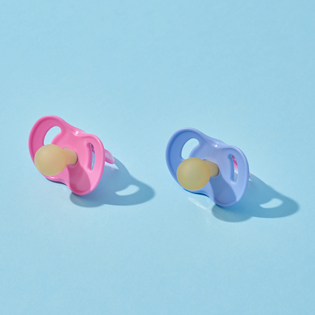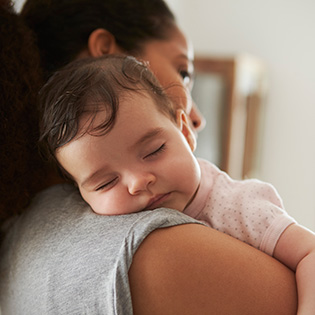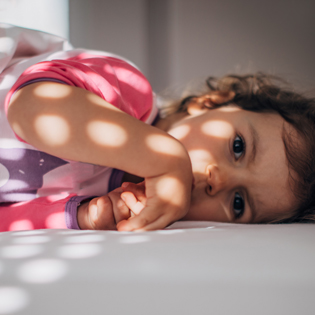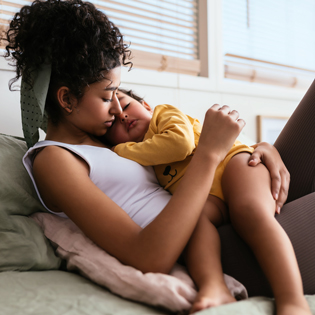You can probably tell just by looking at your little one if she has a stuffy nose or even a fever. But it can be harder to spot a sore throat, especially since your baby or young toddler can’t describe how she’s feeling.
Worrying that you might miss one of your sweetie’s symptoms can be nerve-wracking, of course. The good news is that babies and toddlers under 2 don’t tend to complain about sore throats. That’s partly because they don’t have the vocabulary to explain their symptoms — but also because they likely don’t have the body awareness to notice some minor scratchiness. (Phew.)
So if your little one seems uncomfortable, a different symptom may be the culprit.
Even so, it’s worth knowing when a sore throat might be bothering your baby or young toddler so you can do what you can to soothe her — and know when it’s worth calling her pediatrician. Here are some signs that your child’s throat might be hurting and what you can do about it.
How to tell if your baby has a sore throat
Is your little one’s congestion or cough also making her throat hurt? It can be tough to tell for certain when your child is too young to explain what’s ailing her, so you’ll need to do a little bit of detective work.
Some clues that your sweetie might be suffering from a sore throat include:
- She refuses to eat or drink, even foods that are normally favorites.
- She cries or seems to be in pain when swallowing.
- The glands on the sides of her neck look or feel swollen.
- The back of her throat looks red or swollen.
- She has white spots on her throat or tonsils (a possible sign of strep throat).
- Her breath smells bad.
What can cause a sore throat in babies?
Most, but not all, sore throats are caused by an underlying condition. In some cases, they can also be triggered by environmental factors. Here’s how to tell what’s most likely affecting your little one.
Recommended Reading
Colds
They’re by far the most common cause of sore, scratchy throats in babies and toddlers — and can also lead to a runny nose or congestion, coughing and a fever.
Caused by a virus, colds are respiratory illnesses that can’t be treated with antibiotics unless they lead to a bacterial infection. You should never give over-the-counter cold medicines to children under 6.[1] They don't work well in kids younger than 12, and they're more likely to have side effects — so speak to your pediatrician before using any cough or cold meds, even if your child is technically old enough.
Most of the time, colds simply have to run their course, which typically happens in 10 to 14 days.
The flu
Like the common cold, the flu is another viral respiratory illness that can trigger a sore throat. The difference? Influenza symptoms tend to be more intense, causing a fever, chills, coughing, a runny nose or congestion, fatigue, body aches and occasionally nausea or vomiting.
Like a cold, there’s no cure for the flu. But depending on your child’s age, medical history and symptoms, her pediatrician may recommend over-the-counter fever-reducing meds or a prescription antiviral drug. For example, children under the age of 2 and kids with asthma may need antiviral meds.
COVID-19
A sore throat is one symptom that can accompany a COVID-19 infection. Your child may also have a fever, cough, shortness of breath, fatigue, loss of taste or smell, chills, muscle pain, headache, congestion, nausea or diarrhea. If you suspect your little one has caught the coronavirus, call your pediatrician and ask about testing and quarantining.
With mild cases, you can use the same treatments you would for a cold: rest, lots of fluids and infant acetaminophen or ibuprofen to relieve fever. A cool-mist humidifier and saline nose drops can also help.
Call the doctor right away if your child has trouble breathing; can't wake up or stay awake; has pale, gray or blue-colored skin or lips; or has a fever 100.4 degrees Fahrenheit or higher if under 3 months old, or a prolonged fever if 3 months or older.
Hand, foot and mouth disease
Hand, foot and mouth disease is another viral illness that’s common in young children, especially in the summer and fall.[2] One of the hallmark signs is mouth and throat pain, which is caused by the formation of tiny blisters or sores that make it painful to swallow.
Other common symptoms include fever, small red bumps or blisters (especially on the hands, feet, buttocks and around the mouth) and fever.
Herpangina
Caused by the same virus as hand, foot and mouth disease, herpangina causes ulcer-like sores to form in the mouth and throat that can cause pain, as well as a fever and trouble swallowing.[3] (The ulcers tend to have a white-gray center and a red border.)
Herpangina is most common in kids ages 3 to 10, but younger babies and toddlers can catch it, too.
Strep throat
A bacterial infection, strep is typically marked in kids older than 3 by throat soreness and trouble swallowing, tonsils that seem red and covered with white dots or pus, fever and swollen glands. Some kids also develop a red, sandpaper-like rash on their bodies, but symptoms like coughing and a runny nose are less common.
Strep is rare in infants and toddlers, but if your child does come down with it, it can be treated with antibiotics. In little ones younger than 3, the most common signs include prolonged low-grade fever, runny nose, irritability, swollen lymph nodes and poor appetite.
Allergies
Seasonal allergies are rare in babies under 1, and most children don't develop allergies until the preschool years — although some can have symptoms sooner. Some of the most common triggers include pet dander, mold, dust, grass and pollen.
Allergies can cause a runny nose and postnasal drip, which can lead to a sore throat. Itchy eyes, sneezing and congestion are other common allergy culprits.
If your little one has an allergy, her symptoms will flare up after she’s been exposed to the allergen (like going outside on a day when the pollen counts are high).
Irritants
If you’ve ever started coughing after being somewhere smoky or dusty, you know that environmental irritants can sometimes cause a painful or scratchy feeling in your throat. And the same is potentially true for your little one — exposure to indoor and outdoor air pollution, along with smoke and chemical irritants, can make her throat hurt
This is just one of the many important reasons why you should never smoke around your baby or toddler, as well as take steps to keep the air in her environment as clean as possible.
Sore throat home remedies for babies and toddlers
If a sore throat seems to be making your sweetie uncomfortable or is disrupting her (and your) sleep, you’ve got plenty of tools in your feel-better toolbox.
Sore throat home treatment for babies and toddlers of all ages:
- Run a cool-mist humidifier in your baby or toddler’s room or spend some time in the bathroom with a steamy shower running in the background, which can relieve throat dryness.
- Use nasal saline drops to break up mucus. Then suck it out with a nasal aspirator to keep mucus from irritating the back of the throat.
- For babies who have started solid foods, offer small amounts of water.
Sore throat home treatment for toddlers 1 and older:
- Offer a teaspoon of honey, which can thin mucus and ease coughing. (Never give honey to babies under age 1 — it won’t help with symptoms and can cause infant botulism.)
- Offer warm fluids like chicken broth or cold foods like ice pops.
Sore throat home treatment for toddlers 2 and older:
- For sore throats caused by coughing, apply a layer of mentholated rub on your child’s chest and neck. (Avoid products with camphor when possible, and definitely keep them out of kids' reach.) Never use mentholated rubs in babies and toddlers under 2.
When should you seek help for a sore throat in babies and toddlers?
If your little one’s sore throat is only accompanied by mild cold symptoms, give the pediatrician a call if your child’s symptoms worsen or if her sore throat is still bothering her after a day.
Other, more intense symptoms might warrant a call sooner. You should check in with the doc for a sore throat paired with other symptoms like:
- Fever
- Stomach ache
- Trouble swallowing or not drinking liquids
- Signs of dehydration
- Drooling
- Labored or noisy breathing
- Extreme fatigue
- Pus in the back of the throat
Talking with or seeing the pediatrician can give you peace of mind, and he or she can let you know about other signs to watch for that might warrant a second call or visit.











































 Trending On What to Expect
Trending On What to Expect





